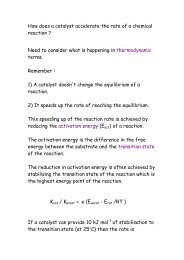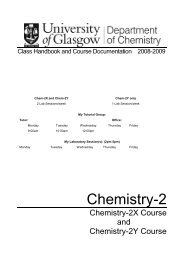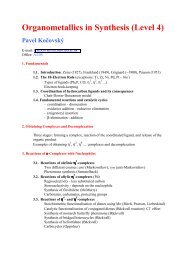Typical examination questions (with answer notes)
Typical examination questions (with answer notes)
Typical examination questions (with answer notes)
Create successful ePaper yourself
Turn your PDF publications into a flip-book with our unique Google optimized e-Paper software.
Chemistry <strong>with</strong> Medicinal Chemistry (CMC)-3<br />
Biophysical Chemistry Module<br />
Biomolecular Interactions (Professor Alan Cooper)<br />
<strong>Typical</strong> <strong>examination</strong> <strong>questions</strong> (<strong>with</strong> <strong>answer</strong> <strong>notes</strong>)<br />
The following <strong>questions</strong> are adapted from previous class/degree <strong>examination</strong>s in this topic<br />
(both 3 rd year and Finals papers).<br />
Answer <strong>notes</strong> do not necessarily comprise the full solution, and are provided for your<br />
guidance only.<br />
You are strongly advised to attempt each of the <strong>questions</strong> before consulting the <strong>answer</strong><br />
<strong>notes</strong>.<br />
Please be aware that slight variations in course content from year to year may be reflected<br />
in these sample <strong>questions</strong>.<br />
AC: November 2000
Qu. 1 (a) What is the “Levinthal Paradox” in the context of protein folding ? Describe how it arises and<br />
discuss its implications for the mechanism of protein folding.<br />
[6]<br />
(b)<br />
Thermal stability studies have given the following (partial) thermodynamic data for unfolding of a<br />
protein in aqueous solution at pH 7.4 at different temperatures:<br />
t K ∆G° ∆H° ∆S°<br />
/°C /kJ mol -1 /kJ mol -1 /J K -1 mol -1<br />
45 0.133 5.33 150.0 ?<br />
50 ? 2.86 175.0 ?<br />
55 ? 0 200.0 609.8<br />
60 3.22 ? 225.0 ?<br />
(i) Complete this table by supplying the missing data (?) where possible.<br />
(ii) What fraction of the protein molecules would be unfolded at 50,55 and 60°C, respectively, under<br />
these conditions ?<br />
(iii) What does the temperature dependence of the unfolding enthalpy (∆H°) suggest about the forces<br />
responsible for stabilizing the folded protein conformation ?<br />
[10]<br />
(c)<br />
The complete genome sequence of a simple nematode worm (C. elegans) has just been completed.<br />
One of the major tasks now is to identify the function of many of the gene products. Glasgow<br />
scientists have identified one protein that might have metal-binding properties. Give three different<br />
biophysical techniques that might be used to investigate the binding of metal ions to this protein in<br />
solution. In each case describe the theoretical basis of the method and indicate how thermodynamic<br />
information may be derived.<br />
[9]<br />
[Gas constant R = 8.314 J K -1 mol -1 ; zero of the Celsius scale = 273.15 K]<br />
Qu. 2 (a)<br />
(b)<br />
Describe the molecular basis for some of the anomalous properties of liquid water and explain the<br />
significance of this <strong>with</strong> regard to hydrogen bonding and hydrophobic interactions in biomolecules.<br />
[6]<br />
The dimerization of N-methylacetamide in solution has frequently been used as a model system for<br />
inter-peptide hydrogen bonds in proteins. Some data for the dimerization equilibrium constant (K)<br />
and enthalpy of dimerization at 25°C in various solvents are given below:<br />
Solvent K ∆G° ∆H° ∆S°<br />
/M -1 /kJ mol -1 /kJ mol -1 /J K -1 mol -1<br />
CCl 4 4.7 ? -17.6 ?<br />
Dioxane 0.52 ? - 3.3 ?<br />
Water 0.005 ? 0 ?<br />
Supply the missing thermodynamic data in the table (?) and explain what these data might suggest<br />
about the role of H-bonding in biomolecular interactions.<br />
[7]
(c)<br />
(d)<br />
Describe three different experimental techniques that may be used to monitor the unfolding of a<br />
protein molecule <strong>with</strong> change in temperature. In each case explain the physical basis for the method<br />
and the nature of the results that might be observed. How could the Gibbs free energy of unfolding<br />
be determined from such measurements ?<br />
[7]<br />
What is meant by the heat capacity increment (∆Cp) for protein unfolding ? How might it be<br />
measured and what is it significance to understanding the forces responsible for protein folding<br />
stability ?<br />
[5]<br />
Qu. 3 (a) List and explain some of the anomalous properties of water, and describe how they might relate to<br />
the forces responsible for stabilising protein and other biomolecular structures.<br />
[7]<br />
(b)<br />
(c)<br />
Describe experimental techniques using model compounds that might be used to obtain information<br />
about the thermodynamics of hydrophobic interactions and hydrogen bonding in the context of<br />
protein folding.<br />
[6]<br />
The following experimental data have been obtained for the fluorescence intensity (F) and circular<br />
dichroism intensity (CD) of a protein solution at different temperatures.<br />
T /°C F (arbitrary units) CD (arbitrary units)<br />
20 65.0 -1310<br />
30 65.0 -1310<br />
40 64.7 -1304<br />
46 58.8 -1186<br />
50 40.0 -810<br />
56 17.8 -366<br />
60 15.5 -320<br />
70 15.0 -310<br />
80 15.0 -310<br />
What is the T m of this protein ?<br />
What fraction of the protein might be unfolded at 46 °C, and what is the Gibbs free energy of<br />
unfolding at this temperature ?<br />
[7]<br />
(d)<br />
Explain what molecular properties are being monitored by the two different sets of data in (c). Do<br />
the transitions monitored by fluorescence and CD necessarily have to occur at the same temperature<br />
? If not, explain why not.<br />
[5]<br />
[Gas constant R = 8.314 J K -1 mol -1 ; zero of the Celsius scale = 273.15 K]<br />
Qu. 4 (a) Describe, <strong>with</strong> appropriate examples and definitions, how the thermodynamics of hydrogen bonding<br />
and hydrophobic interactions can be studied experimentally by use of small model compounds.<br />
[8]
(b)<br />
(c)<br />
Discuss the role of hydrogen bonding and hydrophobic interactions in stabilising the folded<br />
conformations of globular proteins. What is the current view regarding the relative importance of the<br />
contributions from these two interactions ?<br />
[5]<br />
There is currently considerable concern regarding the environmental levels of plasticisers and their<br />
potential effects on male sexual development. Why might these compounds be of concern ?<br />
[3]<br />
(d) A series of organic compounds <strong>with</strong> increasing levels of methyl group substitution, X-(CH 2 ) n -CH 3 ,<br />
are under investigation as potentially more environmentally-friendly plasticisers. Using groupadditivity<br />
data, the following values have been obtained for the predicted free energy of transfer of<br />
such compounds from cyclohexane to water at 25 °C :-<br />
n ∆G° transfer (cyclohexane→water) / kJ mol -1<br />
2 - 0.2<br />
4 + 6.9<br />
8 + 21.1<br />
Calculate the partition (distribution) coefficient, D, for each of these compounds, defining carefully<br />
what you mean by this quantity.<br />
[6]<br />
Discuss how these data might affect your choice of which compound might be the best choice for its<br />
use as a plasticiser, and how such molecules might bind to hydrophobic binding sites on transport<br />
proteins and hormone receptors.<br />
[3]<br />
[Gas constant R = 8.314 J K -1 mol -1 ; zero of the Celsius scale = 273.15 K]<br />
Qu. 5 (a) List and describe briefly the different non-covalent interactions thought to be involved in stabilizing<br />
protein folding and protein-ligand binding interactions in solution. In each case, discuss the role of<br />
solvent water and how it might affect the interaction.<br />
[6]<br />
(b)<br />
(c)<br />
(d)<br />
What are the typical thermodynamic features for thermal unfolding of a globular protein in solution<br />
and how are they determined experimentally ? What do they suggest about the dominant<br />
interaction(s) responsible for stabilizing the folded conformation ?<br />
[7]<br />
Describe the equilibrium dialysis method for determining protein-ligand binding affinities. For<br />
binding of a ligand (L) to a protein (P) to form a 1:1 complex (PL), show that: c p /[PL] = 1 +<br />
1/K[L] , where K is the equilibrium constant and c p is the total protein concentration. Explain how<br />
this expression is used to analyse equilibrium dialysis data.<br />
[6]<br />
In an equilibrium dialysis experiment to study the binding of a new organic ligand to a soluble<br />
receptor protein, the following data were obtained:
Left-hand (protein + ligand) compartment:<br />
Total protein concentration<br />
Total ligand concentration<br />
Right-hand (ligand only) compartment:<br />
Total ligand concentration<br />
= 8.3 x 10 -9 M<br />
= 3.9 x 10 -8 M<br />
= 3.5 x 10 -8 M<br />
What is the equilibrium binding constant for this process ?<br />
[6]<br />
Qu. 6 (a) Sequence analysis in the Human Genome Project has identified a new class of proteins <strong>with</strong> hitherto<br />
unknown properties. List the different biophysical techniques (at least three) that might be used to<br />
investigate the folding stability and interactions of these proteins in solution. In each case describe<br />
the theoretical basis of the method and indicate how thermodynamic information may be derived.<br />
[9]<br />
(b)<br />
Thermal stability studies of one of the proteins in this family have given the following (partial)<br />
thermodynamic data for unfolding of the protein in aqueous solution at pH 7.4 at different<br />
temperatures:<br />
t K ∆G° ∆H° ∆S°<br />
/°C /kJ mol -1 /kJ mol -1 /J K -1 mol -1<br />
35 0.28 3.26 75.0 ?<br />
40 ? 2.02 100.0 ?<br />
45 ? 0 125.0 392.9<br />
50 2.85 ? 150.0 ?<br />
(i) Complete this table by supplying the missing data (?) where possible.<br />
(ii) What fraction of the protein molecules would be unfolded at 40, 45 and 50°C, respectively,<br />
under these conditions ?<br />
(iii) What does the temperature dependence of the unfolding enthalpy (∆H°) suggest about the forces<br />
responsible for stabilizing the folded protein conformation ?<br />
[10]<br />
(c)<br />
What is the “Levinthal Paradox” in the context of protein folding ? Describe how it arises and<br />
discuss its implications for the mechanism of protein folding.<br />
[6]<br />
[Gas constant R = 8.314 J K -1 mol -1 ; zero of the Celsius scale = 273.15 K]<br />
Qu. 7 (a)<br />
List some of the anomalous properties of liquid water and how they can be rationalised in terms of<br />
what we know about the molecular structure and interactions of water. Explain the significance of<br />
this <strong>with</strong> regard to hydrogen bonding and hydrophobic interactions in biomolecules. [6]<br />
(b) The dimerization of carboxylic acids in solution has sometimes been used as a model system for -<br />
C=O...HO- hydrogen bonds in proteins. Some data for the dimerization equilibrium constant (K)<br />
and enthalpy of dimerization at 25°C of a particular carboxylic acid in various solvents are given<br />
below:
Solvent K ∆G° ∆H° ∆S°<br />
/M -1 /kJ mol -1 /kJ mol -1 /J K -1 mol -1<br />
CCl 4 10.3 ? -15.6 ?<br />
Dioxane 0.7 ? - 3.5 ?<br />
Water 0.001 ? 0 ?<br />
Supply the missing thermodynamic data in the table (?) and explain what these data might suggest<br />
about the role of H-bonding in biomolecular interactions. [7]<br />
(c)<br />
(d)<br />
Describe three different experimental techniques that may be used to monitor the unfolding of a<br />
protein molecule <strong>with</strong> change in temperature. In each case explain the physical basis for the method<br />
and the nature of the results that might be observed. How could the Gibbs free energy of unfolding<br />
be determined from such measurements ? [6]<br />
Discuss briefly what effects might be relevant in designing a drug for delivery across biological<br />
membranes and how this might be studied experimentally <strong>with</strong> simple model systems. [6]<br />
Qu. 8 (a) A new, virulent form of teenage acne has struck the West of Scotland. As senior biophysical chemist<br />
at PanGalacticDrugCo you have been charged <strong>with</strong> the task of identifying possible compounds that<br />
might bind to the viral protein involved. List the various techniques you might use to determine the<br />
binding of small molecular ligands to proteins. In each case, describe briefly the basis of the method<br />
and the sort of information that may be obtained. [8]<br />
(b)<br />
One of the proteins responsible for the effects of teenage mutant acne is thought to contain a<br />
hydrophobic binding site that might be a potential target for drugs. Organic chemists in your<br />
company have synthesized three possible compounds, and your junior colleagues have measured the<br />
partitioning of these molecules between cyclohexane and water at 25°C as follows:<br />
Drug #<br />
D = [Drug] cyclohex /[Drug] water<br />
ZitBlast-A 9.7 x 10 -4<br />
ZitBlast-B 4.3<br />
ZitBlast-C 7.6 x 10 3<br />
Estimate the Gibbs free energy of transfer of each drug from water to cyclohexane. Suggest which of<br />
these drugs might be the best candidate for binding to this protein, and why.<br />
[8]<br />
(c)<br />
Meanwhile, your old granny suggests that simply washing the spots <strong>with</strong> vinegar worked well<br />
enough in her day. Measurement of the tryptophan fluorescence of the relevant protein at different<br />
pH’s gives the following data:<br />
pH<br />
Fluorescence at 335nm (arbitrary units)<br />
1.5 5<br />
2.0 5<br />
2.5 10<br />
3.0 35<br />
3.5 70<br />
4.0 95<br />
5.0 100<br />
7.0 100
Is your granny right ? Interpret the above data in terms of protein unfolding. Estimate the free<br />
energy of unfolding at pH 2.5 and pH 3.5. What protein groups might be responsible for this pH<br />
behaviour ? [9]<br />
Qu. 9 (a) Describe, briefly, the various kinds of interactions that may be involved in stabilising folded protein<br />
structures. In each case, explain how the interaction may be affected by the presence of water. [7]<br />
(b)<br />
The dipolar properties of -NH and -C=O groups in polypeptides might be represented as follows in<br />
terms of partial charges:<br />
-0.28 +0.28 +0.39 -0.39<br />
N H C O<br />
102 pm 124 pm<br />
Calculate the dipole moments of each of these groups.<br />
If these dipoles were placed in line, 4.5 Å apart in vacuum, what might be the interaction potential<br />
energy between them ? How might the presence of solvent water molecules affect this ? [8]<br />
(c)<br />
For a particular protein at pH 6.3 the fraction unfolded at different temperatures is found to be:-<br />
t /°C<br />
Fraction unfolded<br />
58.5 0.012<br />
63.5 0.101<br />
68.5 0.500<br />
73.5 0.896<br />
78.5 0.985<br />
What is T m for this protein and what is the free energy of unfolding (∆G° unf ) at this temperature ?<br />
Estimate ∆G° unf at 63.5 °C and at 73.5 °C . Hence estimate the enthalpy and entropy of unfolding of<br />
the protein under these conditions.<br />
[10]<br />
[ε 0 = 8.85 x 10 -12 J -1 C 2 m -1 ]<br />
Qu. 10 (a)<br />
Explain the practical and theoretical basis of the equilibrium dialysis method for measuring ligand<br />
binding to biological macromolecules. What other methods might be used to measure protein-ligand<br />
binding, and how do they differ fundamentally from equilibrium dialysis ?<br />
[7]<br />
(b) Starting from the equilibrium expression for binding of a ligand(L) to a protein (P) to form a 1:1<br />
complex (PL), show that:<br />
c p /[PL] = 1 + 1/K[L]<br />
where K is the equilibrium constant and c p is the total protein concentration.<br />
How might this expression be used to obtain ligand binding data graphically from equilibrium<br />
dialysis data ?<br />
[6]
(c)<br />
In an equilibrium dialysis experiment to study the binding of a putative anti-cancer drug (Q) to a<br />
receptor protein (R), the following data were obtained:<br />
Left-hand (protein + ligand) compartment:<br />
Total protein concentration = 9.2 x 10 -9 M<br />
Total ligand concentration = 4.06 x 10 -8 M<br />
Right-hand (ligand only) compartment:<br />
Total ligand concentration = 3.60 x 10 -8 M<br />
What is the equilibrium binding constant for this process ?<br />
[6]<br />
(d)<br />
Discuss briefly what effects might be relevant in designing a drug for delivery across biological<br />
membranes and how this might be studied experimentally <strong>with</strong> simple model systems.<br />
[6]<br />
[Answer <strong>notes</strong> start on next page]
Answer Notes<br />
[Do not consult these until you have attempted the <strong>questions</strong>.]<br />
1. (a) Levinthal paradox - too many polypeptide conformers to explore in realistic timescale. Numerical<br />
estimate: e.g. assume 3 x 3 = 9 possible Φ-Ψ angles per peptide, leads to typically 100 9 possible<br />
conformers for typical protein. Implies that protein folding must follow specific pathways.<br />
(b)<br />
(i) Use ∆G° = -RT.ln(K) = ∆H° -T.∆S° to complete:-<br />
t K ∆G° ∆H° ∆S°<br />
/°C /kJ mol -1 /kJ mol -1 /J K -1 mol -1<br />
45 0.133 5.33 150.0 454.9<br />
50 0.345 2.86 175.0 532.9<br />
55 1 0 200.0 609.8<br />
60 3.22 -3.24 225.0 685.4<br />
(ii) Fraction unfolded = K/(1+K) = 0.26, 0.5, 0.76 (respectively)<br />
(iii) Increase in ∆H° <strong>with</strong> temperature (confirmed by increase in ∆S° <strong>with</strong> T) signifies a positive<br />
heat capacity increment (∆Cp), characteristic of hydrophobic stabilizing interactions.<br />
(c)<br />
Spectroscopic methods (UV, fluorescence, CD)-changes in environment/conformation on binding<br />
Hydrodynamics (viscosity, sedimentation)-changes in gross macromolecular properties<br />
Calorimetry (DSC, ITC)-direct measure of energy changes on binding<br />
Equilibrium dialysis-direct measure of ligand binding<br />
- all covered in lectures. Thermodynamic information may be obtained indirectly from temperature<br />
dependence, ∆G° = -RT.ln(K) = ∆H° -T.∆S° , etc., or directly (∆H° , ∆Cp) by microcalorimetry.<br />
2. (a) Standard lecture material. High m.p./b.p., high density of liquid (ice floats), high dielectric, 4°C<br />
max density, heat capacity, etc... H-bonding, residual open tetrahedral lattice structure... ∴<br />
hydrogen bonding between biomolecular groups generally unfavourable in water (water mols<br />
compete for H-bonding sites), but hydrophobic interactions (arising from structural propoerties of<br />
liquid water) more significant..<br />
(b) Use K = [NMA 2 ]/[NMA] 2 ; ∆G° = -RT.ln(K) = ∆H° - T.∆S°<br />
Results (for 25 °C):<br />
Solvent K ∆G° ∆H° ∆S°<br />
/M -1 /kJ mol -1 /kJ mol -1 /J K -1 mol -1<br />
CCl 4 4.7 - 3.8 -17.6 - 46<br />
Dioxane 0.52 + 1.6 - 3.3 - 16.5<br />
Water 0.005 + 13.1 0 - 44<br />
Suggests H-bonding unfavourable in polar solvents.
(c)<br />
(d)<br />
Anything sensible from: UV difference, fluorescence, CD, nmr, viscosity, hydrodynamic effects,<br />
DSC, etc. (all done in lectures). Use ∆G° = -RT.ln(K), where K = [U]/[N] = (F-F 0 )/(F inf - F), for<br />
any observable F.<br />
Positive increase in excess heat capacity of unfolded protein w.r.t. folded. Observed from<br />
temperature dependence of ∆H or calorimetric (DSC) studies. Characteristic of hydrophobic<br />
contribution to protein folding.<br />
3. (a) Standard lecture material: High mp/bp, density increase on melting (ice floats), high dielectric, 4 °C<br />
max density, high heat capacity... Water dipole, H-bonding, residual open tetrahedral lattice structure<br />
∴hydrogen bonding between biomolecular groups generally unfavourable in water (water molecules<br />
compete for H-bonding sites), but hydrophobic interactions (arising from structural properties of<br />
liquid water) more significant.<br />
[7]<br />
(b)<br />
(c)<br />
Partitioning between solvents, gaseous dimers<br />
Liquid phase dimerization of peptide analogues (e.g. N-methyl acetamide)<br />
Different results in aqueous/non-aqueous systems<br />
Polar vs. non-polar environments in folded/unfolded proteins - [lecture material]<br />
Both F and CD follow the same transition in this case, so may use either.<br />
[6]<br />
T m = 50 °C<br />
(mid-point of unfolding transition)<br />
Fraction unfolded = (F - F 0 )/(F inf - F 0 ) = (58.8 - 65)/(15 - 65) = 0.124<br />
Equilib.const. for unfolding<br />
K = (F - F 0 )/(F inf - F) = (58.8 - 65)/(15 - 58.8)<br />
= 0.142<br />
∆G° unf = -RT.lnK = -8.314 x (273 + 46) x ln(0.142) = + 5.18 kJ mol -1 [7]<br />
(d)<br />
Fluorescence is probing the polarity of the environment of aromatic amino acid residues (primarily<br />
tryptophan), which changes (non-polar --> polar) as the protein unfolds. CD measures secondary<br />
structure changes (α-helix, β-sheet, etc.). These do not necessarily occur simultaneously, since<br />
protein unfolding may take place in two (or more) steps, e.g. change in tertiary structure exposing<br />
aromatic groups but retaining secondary structure, followed by “melting” of the secondary structure<br />
at higher temperatures.<br />
[5]<br />
4. (a) Gas phase dimerization, e.g. formic acid<br />
Liquid phase dimerization of peptide analogues (e.g. N-methyl acetamide)<br />
Different results in aqueous/non-aqueous systems - [lecture material]<br />
[8]<br />
(b)<br />
Hydrogen bonds required for structure, but do not necessarily contribute to stability, because of<br />
competing H-bonds <strong>with</strong> water. Hydrophobic interactions are most likely source of stability,<br />
supported by evidence from thermodynamics (∆C p , etc.) - [lecture material]<br />
[5]
(c)<br />
Plasticisers are hydrophobic compounds that can mimic endocrines and act as feminizing hormones<br />
by binding to receptor and fatty-acid transport proteins - [tutorial material]<br />
[3]<br />
(d) D = [A] water /[A] cyclohexane (or equivalent)<br />
∆G° transfer (cyclohexane→water) = -RT.lnD<br />
hence D....<br />
n ∆G° transfer / kJ mol -1 D = exp(-∆G° transfer x 1000/8.314x298)<br />
2 - 0.2 1.1<br />
4 + 6.9 0.06<br />
8 + 21.1 0.0002<br />
[6]<br />
n = 8 probably best since, even though this would probably also act best as an endocrine disrupter, it<br />
will have the least propensity to leach into aqueous environment. (Or anything equally sensible, or<br />
better !)<br />
[3]<br />
[25 marks total]<br />
5. (a) Standard lecture material - electrostatics, charge-charge, dipole-dipole, etc., H-bonds, hydrophobic<br />
interactions, London dispersion forces. Water can affect indirectly (via dielectric constant effect) or<br />
directly (via H-bonding to water mols.). Water is essential for hydrophobic interaction !<br />
(b)<br />
(c)<br />
For globular protein unfolding:<br />
∆H° unf normally positive (endothermic), but temperature dependent (positive ∆Cp)<br />
∆S° unf normally positive (favourable), again depends on T.<br />
∆G° unf positive below T m , negative above T m , T m = ∆H° /∆S°<br />
Need to overcome large configurational entropy of unfolded polypeptide chain to stabilise folded<br />
conformation.<br />
∆G° per residue much less than RT, therefore folding must be cooperative.<br />
Positive heat capacity increment (∆Cp) conventionally taken to be characteristic of hydrophobic<br />
interactions (from small model compounds).<br />
Determined by microcalorimetry or temperature dependence of spectroscopic properties, etc.<br />
Equilibrium dialysis (from lectures) - two compartments, semi-permeable membrane,<br />
protein/macromolecule confined to one side, (small) ligand free to move across membrane so that, at<br />
equilibrium, measurements of total protein and total ligand either side of membrane will give all info<br />
necessary to determine K. Appropriate sketch diagram.<br />
P + L PL<br />
c p = [PL] + [P] ; K = [PL]/[P][L]<br />
∴ c p /[PL] = 1 + [P]/[PL] = 1 + 1/K[L] (QED)<br />
Slope of d-r plot = 1/Kc p . Useful because only equilibrium dialysis (and related methods) gives<br />
free ligand concentration [L] directly. For most other methods need to make approximations, or fit<br />
to complete binding expression.
(d) c p = [PL] + [P] = 8.3 x 10 -9 M (from left hand compartment)<br />
c L = [PL] + [L] = 3.9 x 10 -8 M .. ..<br />
Free ligand [L] = 3.5 x 10 -8 M (from right hand compartment)<br />
∴ [PL] = 3.9 x 10 -8 - 3.5 x 10 -8 = 4.0 x 10 -9 M<br />
[P] = 8.3 x 10 -9 - 4.0 x 10 -9 = 4.3 x 10 -9 M<br />
Hence K = [PL]/[P][L] = 2.7 x 10 7 M -1<br />
6. (a) Spectroscopic methods (UV, fluorescence, CD)<br />
-changes in environment/conformation on folding or binding<br />
Hydrodynamics (viscosity, sedimentation)<br />
-changes in gross macromolecular properties<br />
Calorimetry (DSC, ITC)<br />
-direct measure of energy changes on unfolding or binding<br />
Equilibrium dialysis<br />
-direct measure of ligand binding<br />
- all covered in lectures. Thermodynamic information may be obtained indirectly from temperature<br />
dependence, ∆G° = -RT.ln(K) = ∆H° -T.∆S° , etc., or directly (∆H° , ∆Cp) by microcalorimetry.<br />
(b)<br />
(i) Use ∆G° = -RT.ln(K) = ∆H° -T.∆S° to complete:-<br />
t K ∆G° ∆H° ∆S°<br />
/°C /kJ mol -1 /kJ mol -1 /J K -1 mol -1<br />
35 0.28 3.26 75.0 232.8<br />
40 0.46 2.02 100.0 312.9<br />
45 1.0 0 125.0 392.9<br />
50 2.85 -2.81 150.0 472.9<br />
(ii) Fraction unfolded = K/(1+K) = 0.22, 0.5, 0.74 (respectively)<br />
(iii) Increase in ∆H° <strong>with</strong> temperature (confirmed by increase in ∆S° <strong>with</strong> T) signifies a positive<br />
heat capacity increment (∆Cp), characteristic of hydrophobic stabilizing interactions.<br />
(c) Levinthal paradox - too many polypeptide conformers to explore in realistic timescale. Numerical<br />
estimate: e.g. assume 3 x 3 = 9 possible Φ-Ψ angles per peptide, leads to typically 100 9 possible conformers<br />
for typical protein. Implies that protein folding must follow specific pathways.<br />
7. (a) Standard lecture material. High m.p./b.p., high density of liquid (ice floats), high dielectric, 4°C<br />
max density, heat capacity, etc... H-bonding, residual open tetrahedral lattice structure... ∴<br />
hydrogen bonding between biomolecular groups generally unfavourable in water (water mols<br />
compete for H-bonding sites), but hydrophobic interactions (arising from structural properties of<br />
liquid water) more significant..
(b) Use K = [dimer]/[monomer] 2 ; ∆G° = -RT.ln(K) = ∆H° - T.∆S°<br />
Results (for 25 °C):<br />
Solvent K ∆G° ∆H° ∆S°<br />
/M -1 /kJ mol -1 /kJ mol -1 /J K -1 mol -1<br />
CCl 4 10.3 -5.8 -15.6 -32.9<br />
Dioxane 0.7 +0.9 - 3.5 -14.8<br />
Water 0.001 +17.1 0 -57.4<br />
Suggests H-bonding unfavourable in polar solvents.<br />
(c)<br />
Anything sensible from: UV difference, fluorescence, CD, nmr, viscosity, hydrodynamic effects, DSC, etc.<br />
(all done in lectures). Use ∆G° = -RT.ln(K), where K = [U]/[N] = (F-F 0 )/(F inf - F), for any observable F.<br />
(d) Discussed in lectures/tutorials. Polarity, relative solubility in aqueous/organic phases. Measure<br />
distribution/partition coeffs.<br />
8. (a) Equilibrium dialysis: direct method --> no. of binding sites (n), binding const. (K)<br />
UV/fluorescence changes: indirect method --> n, K, polarity of binding site?<br />
In both of above: K --> ∆G° , temperature dependence --> ∆H° and ∆S°<br />
Microcalorimetry methods --> n, K and direct measure of ∆H° and ∆S°<br />
(b) D ∆G(water-->cyclohexane) = RT.ln(D)<br />
ZitBlast-A 9.7 x 10 -4 -17.2 kJ mol -1<br />
ZitBlast-B 4.3 3.6 ..<br />
ZitBlast-C 7.6 x 10 3 22.1 ..<br />
ZitBlast-A possibly best candidate for binding to hydrophobic site, assuming cyclohexane is a reasonable<br />
model for hydrophobic environment. Partitions favourably into cyclohexane, negative ∆G transfer .<br />
(c)<br />
Protein is folded (presumably) at neutral pH and unfolds at low pH. Buried tryptophans become<br />
exposed to more polar environment, hence decrease in relative fluorescence.<br />
pH of vinegar (dilute ethanoic acid) ≈ 2-3, ∴ granny possibly right.<br />
For a 2-state unfolding transition: N U , K = [U]/[N]<br />
K = (F - F0)/(Finf - F) ; ∆G° unf = -RT.lnK<br />
Assuming F 0 (high pH) = 100, and F inf (low pH) = 5, T = 25 °C = 298 K<br />
pH 2.5: K = (10 - 100)/(5 - 10) = 18 ∆G° unf = -7.2 kJ mol -1<br />
pH 3.5: K = (70 - 100)/(5 - 70) = 0.46 ∆G° unf = +1.9 kJ mol -1<br />
Mid-point pH in region 2-3, therefore protein groups titrating in this region most likely responsible,<br />
aspartic/glutamic/C-terminal -COOH
9. (a) Standard lecture material - electrostatics, charge-charge, dipole-dipole, etc., H-bonds, hydrophobic<br />
interactions, London dispersion forces. Water can affect indirectly (via dielectric constant effect) or<br />
directly (via H-bonding to water mols.). Water is essential for hydrophobic interaction !<br />
(b)<br />
Dipole moment µ = charge x distance ; 1 Debye ≡ 3.336 x 10 -30 Cm<br />
µ NH = 0.28 x 1.6 x 10 -19 x 102 x 10 -12 = 4.6 x 10 -30 Cm ≡ 1.37 D<br />
µ CO = 0.39 x 1.6 x 10 -19 x 124 x 10 -12 = 7.7 x 10 -30 Cm ≡ 2.32 D<br />
V µµ (in line) ≈ ± 2.µ 1 µ 2 /4πε 0 ε r r 3<br />
≈ ± 7.0 x 10 -21 J ≡ 4.25 kJ mol -1 (in vacuo)<br />
In water:<br />
(i) continuous dielectric effect would reduce this by factor ≈80<br />
(ii) in reality, H-bonds <strong>with</strong> water might compete<br />
(c) N U ; K = [U]/[N] = f/(1-f) where f = [U]/([N]+[U]) = fraction unfolded.<br />
∆G° unf = -RT.lnK = ∆H° - T.∆S° (R=8.314 J K -1 mol -1 , temp. in K)<br />
T m = 68.5 °C ; ∆G° unf = 0<br />
63.5 °C :∆G° unf = + 6.1 kJ mol -1<br />
73.5 °C :∆G° unf = - 6.2 kJ mol -1<br />
∆H° and ∆S° at T m from simultaneous equations of ∆G° = ∆H° - T.∆S° at 2 temperatures (e.g.<br />
63.5 and 73.5 °C )...<br />
Answer: ∆H° unf = +420 kJ mol -1 ; ∆S° unf = +1230 J K -1 mol -1 (note signs).<br />
10. (a) Equilibrium dialysis - anything sensible.... (done in lectures)<br />
Other methods (UV, fluorescence, CD, etc.) are indirect methods, e.g. do not give free ligand concs<br />
directly.<br />
(b) P + L PL<br />
c p = [PL] + [P] ; K = [PL]/[P][L]<br />
∴ c p /[PL] = 1 + [P]/[PL] = 1 + 1/K[L] (QED)<br />
Slope of d-r plot = 1/Kc p .<br />
Useful because only equilibrium dialysis (and related methods) gives free ligand concentration [L]<br />
directly. For most other methods need to make approximations, or fit to complete binding<br />
expression.
(c)<br />
c p = [RQ] + [R] = 9.2 x 10 -9 M<br />
c L = [RQ] + [Q] = 4.06 x 10 -8 M<br />
Free ligand [Q] = 3.60 x 10 -8 M<br />
∴ [RQ] = 4.06 x 10 -8 - 3.60 x 10 -8 = 4.6 x 10 -9 M<br />
[R] = 9.2 x 10 -9 - 4.6 x 10 -9 = 4.6 x 10 -9 M<br />
Hence K = [RQ]/[R][Q] = 2.8 x 10 7 M -1<br />
(d)<br />
Discussed in lectures/tutorials. Polarity, relative solubility in aqueous/organic phases. Measure<br />
distribution/partition coeffs.<br />
END


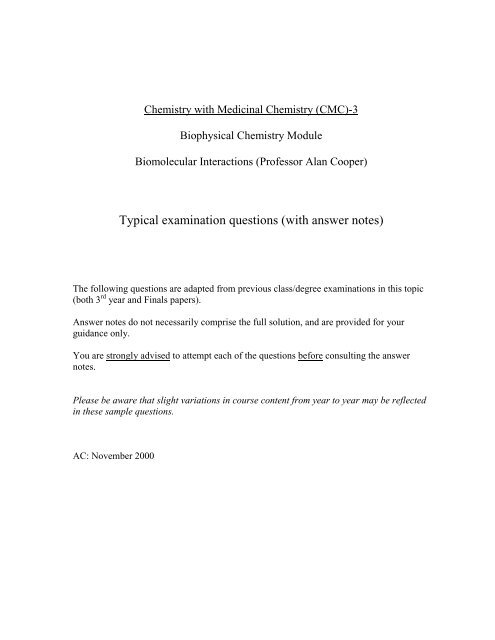
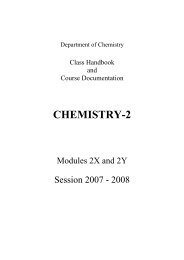

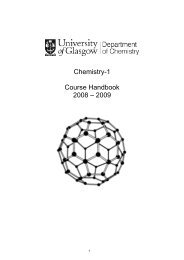
![Chemistry Study [PDF] - University of Glasgow](https://img.yumpu.com/26854063/1/184x260/chemistry-study-pdf-university-of-glasgow.jpg?quality=85)
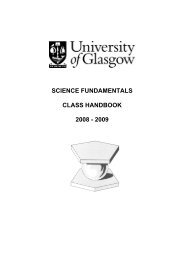


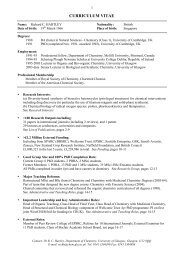

![Environmental Chemistry Study [PDF] - University of Glasgow](https://img.yumpu.com/26854018/1/184x260/environmental-chemistry-study-pdf-university-of-glasgow.jpg?quality=85)


